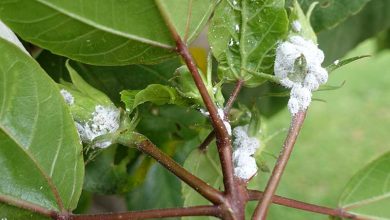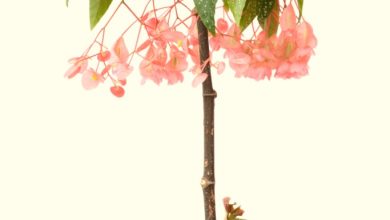Plant The Poinsettia in Your Garden: [Complete Step-by-Step Guide]
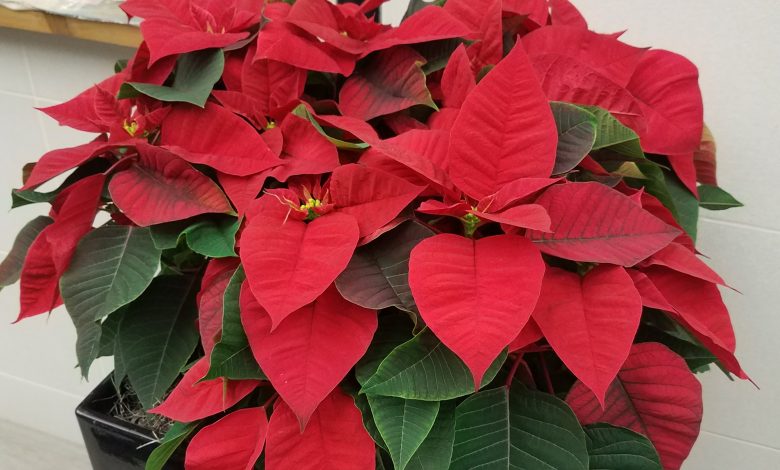
The poinsettia (Euphorbia pulcherrima)it is, par excellence, the Christmas Flower.
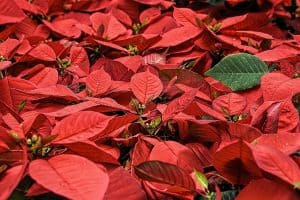 Originally from Mexico and Central America, it has earned its place in many homes around the world during the holidays in December, because precisely at this time it blooms while the other plants are left bare.
Originally from Mexico and Central America, it has earned its place in many homes around the world during the holidays in December, because precisely at this time it blooms while the other plants are left bare.
It has a truly festive appearance, striking for its flowers with very long petals and an intense red. These peculiar leaves are called bracts and can also have other striking pearly colors such as yellow, white, salmon and pink.
It is known under various names throughout the American continent. In Venezuela they call it Christmas Flower or Papagayo; in Argentina Federal Star.
And the name of Poinsettia was given thanks to the person who popularized it, the United States ambassador to Mexico, Joel Roberts Poinsett.
Important points when planting the poinsettia
- When to sow? Your cuttings will sprout perfectly fine in spring .

- Where to do it? In pots it is the most widespread worldwide because they adorn the interior spaces of houses at Christmas.
- Ideal temperature? It lives very well between 15 and 20 °C.
- How to prepare the land? A good substrate with quality organic matter (compost) is essential. A compound fertilizer 12-12-12 helps a lot to grow healthy.
- How do we water? Does not support excess moisture. In summer water twice a week and in winter take care of it without much watering.
- What pests and diseases does it have? The excess of water or the lack of irrigation sensibly affect its bracts or leaves. And the fungi also appear when it is watered poorly and excessively.
When to plant the poinsettia?
They live in an ideal state, in temperatures that oscillatebetween 15 and 20 °C.
Its cuttings are usually prepared in early spring to encourage its multiplication in pots and gardens with very porous soils, where it can reach heights of up to 16 feet and be kept like any perennial plant.
Where to plant the poinsettia?
Did you know…As its use at Christmas has become so popular, at this time worldwide sales exceed 100 million copies sold. They are commonly sold in pots, especially in countries with severe winters, where they must be grown as houseplants.
 These must have a very good drainage system, but if you decide to take advantage of and reproduce them by cuttings, there is a clear procedure: you must place the stems, previously smeared with rooting hormones, in a pot with a substrate with a lot of organic nutrients, very porous and inan area of the house where there is a lot of light.
These must have a very good drainage system, but if you decide to take advantage of and reproduce them by cuttings, there is a clear procedure: you must place the stems, previously smeared with rooting hormones, in a pot with a substrate with a lot of organic nutrients, very porous and inan area of the house where there is a lot of light.
On average, each can be fertilized with a good liquid every 15 days, in the growth period that goes from mid-spring to the end of summer.
Suspend all liquid fertilizer when the leaves or bracts begin to take color, it is very important.
How do we prepare the land for the cultivation of the poinsettia?
Like most floral species, if not all,the poinsettia does not support waterloggingin its roots, so it is necessary to be aware that the substrate is not saturated with water.
This substrate must be rich in organic matter and should also contain a little peat to facilitate constant water drainage.
How do we water the poinsettia?
 Some clear rules must be followed for these cheerful plants if we want to keep them healthy beyond Christmas.
Some clear rules must be followed for these cheerful plants if we want to keep them healthy beyond Christmas.
In summer:water twice a week, allowing the soil to dry out, between each activity.
If we put water in the saucer of the pot, it will absorb what it needs.
In gardens, you also have to be very careful not to saturate the soil when watering twice a week.
How to plant the poinsettia step by step?
If you decide to take advantage of and reproduce the Christmas Flower by cuttings, there is a clear procedure to follow:
- Cut stems or cuttings about 6 cm after all the leaves of the mother plant have fallen.
- Submerge them in warm water to remove excess latex, for about 15 minutes.
- Coat your cuttings with rooting hormones.
- Plant a single cutting in a pot previously prepared with a substrate rich in organic nutrients, very porous and with excellent drainage.
- Locate the pot in an area of the house where there is plenty of light.We are now going to indicate how we can plant the Poinsettia in a garden.
- The first thing we can highlight is that this is only done in countries with mild or nonexistent winter.
- If you bought it in a pot during the winter period, let it sit there until it is suitable for transplanting, which is when the weather gets much warmer. Water it occasionally until spring begins.
- In March or April, cut your plant back to about 20 cm. This pruning will help start a new growth cycle. Water it and wait for the beginning of summer, which is the ideal date to carry out the transplant. Don’t forget to fertilize it once a month, no more than that.
- Locate a site where the Poinsettia receives light in the morning and shade in the afternoon. Prepare the land with a fertile substrate of quality compost.
- Loosen the soil in your garden and dig about 30 or 40 cm in the center, so that the root of the plant is completely covered. Place soil around the stem and place another 5 cm of substrate at the base, so that it is strengthened and well hydrated.
- Add a good fertilizer, but don’t overdo it. A 12-12-12 compound at the beginning of its growth is very good. Repeat this once a month.
- Do not water it excessively because it will grow fungus. Always check that the soil is dry before pouring water on its base.
- It is necessary to prune the Poinsettia during its growth to stimulate it to flower. The shoots will serve to reproduce new plants.
- During the cooler months, add compost at the base of the plant to strengthen it, as long as temperatures don’t drop below 7°C.
In Easter varieties for indoor use, if the heating is very strong in the house, you should place a bucket with water near the radiator to avoid the dryness of the environment and increase humidity, because this condition affects its leaves or bracts.
Did you know…An excellent trick for them to bloom is to leave them in total darkness inside a closet, between the end of September and the beginning of October, for about 14 hours.
Green leaves will change color more quickly. They bloom best at night, when the temperature drops.
This phenomenon runs better after 5:00 pm
What favorable associations does it have?
 Although it is widely grown in pots, it can also be kept in gardens until it reaches the appearance of a bush.
Although it is widely grown in pots, it can also be kept in gardens until it reaches the appearance of a bush.
This occurs in warm areas where winters are severe, as has already been said.
You can take advantage of the time of planting to locate varieties of different colors,which should be combined in a series or circle so that their bracts stand out more during the flowering period.
What pests and diseases does the poinsettia have?
There are several negative indicators that warn us about plant damage.
One of the most serious isobserve black, dark spots on the leaves.Indicates that the plant is dying due to poor watering.
It could be saved if we stop watering, prune it with lots of love and let it rest in a shady place, until it sprouts in the next season.
If the bracts turnyellowish color and fall off,You have to check the environmental conditions, because this usually happens when it is very hot, or because they are exposed to very cold air currents. I also pass this to them when they need light.
It is also a symptom of disease that loses color. They go as discoloration and this happens because of an excess of water. The substrate must be allowed to dry between each watering.
If it acquires a grayish hue, it suffers from brotitis. There is a fungus present. It should be removed with a good fungicide.
Another negative indicator is that the plant feels flaccid, as if fainted. This surely happens because it is exposed to air currents that it does not support. Relocate it to a cool but sunny spot.

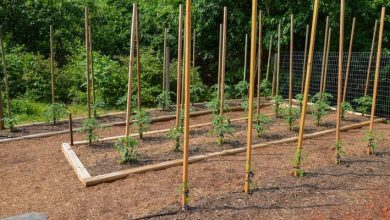
![Photo of Australia Climate: [Characteristics, Flora, Fauna and Adaptability]](https://www.complete-gardening.com/wp-content/uploads/2022/08/australia-climate-characteristics-flora-fauna-and-adaptability-390x220.jpg)
